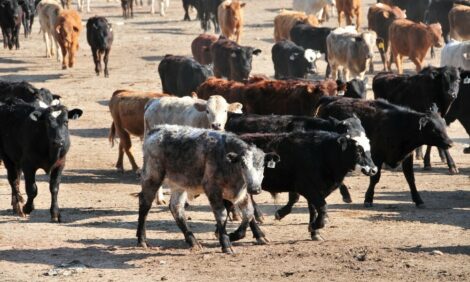



MLA: Weekly Cattle Summary
AUSTRALIA - This report is a collection of weekly cattle price summaries from each Australian territory by Meat & Livestock Australia (MLA).
South Australia
Smaller yardings
There was some welcomed rainfall this week, with producers who received steady soft rain a couple of weeks ago benefiting the most. The rain combined with the lower saleyard prices may have kept some cattle in the paddock, or numbers are starting to come back to their usual smaller winter yardings.
The SA LE’s slightly larger yarding featured improved quality runs of young cattle and cows, attracting stronger competition from the usual trade and export buyers at improved prices. Feeder and restocker orders were active sourcing light and medium weight yearling steers and heifers. The 2 and 3 score medium and heavyweight cows were generally dearer.
Naracoorte’s similar numbered very mixed yarding contained a mixture of local and pastoral bred cattle from Roxby Downs. These sold to selective competition from a small number of SA and Victorian buyers at generally lower prices, with isolated sales being dearer. Restocker and feeder orders were also active at fluctuating prices. Cows were cheaper despite some good quality heavyweights being yarded. In a strange twist B-muscled bulls were up to 15¢/kg dearer.
A very small mixed quality yarding at Mt. Gambier sold at fluctuating prices as the operating buyers tried to source supplies. Feeder and restocker orders were active on a wide range of quality of young cattle and cows.
Fluctuating prices
The selective trade, export, feeder and restocker competition on the mixed quality runs yarded led to fluctuating prices being paid this week.
Small numbers of vealer steers to the trade sold from 165¢ to 216¢, at prices 3¢ to 9¢/kg dearer. Vealer heifer C and B-muscled sales to the trade were from 144¢ to 195¢, to be generally 2¢ to 17¢/kg dearer.
Small yardings of C3 and B-muscled yearling steers to trade inquiry sold between 150¢ and 210¢, to be 10¢ to 14¢/kg dearer. Feeder orders sourced C2 and B1 steers from 150¢ to 175¢, or 8¢/kg cheaper. Yearling heifer C3 medium and heavyweights were unchanged to 4¢ dearer, selling from 140¢ to 190¢/kg.
Small runs of C2 and C3 grown steers and bullocks sold between 155¢ and 181¢/kg. The C-muscled grown heifers sold from 100¢ to 148¢, with the C3 sales 5¢/kg dearer. Cow prices were erratic as most 2 to 6 scores sold from 65¢ to 115¢ to processor, or mainly 150¢ to 230¢/kg cwt. Restockers paid from 82¢ to 114¢ for D2 and C2 medium and heavy beef cows at dearer levels.
Queensland
Supply reduces
The supply of stock varied from centre to centre, however the major markets experienced a decline in numbers and reduced overall supply at physical markets covered by MLAs NLRS by 12%. Some patchy rain in places had a small effect on reducing numbers, and the Longreach sale has now been cancelled for two consecutive weeks.
Young cattle continued to dominate the selling pens and there was a dramatic drop in the supply of grown cattle. The small selection of cows was dominated by poor condition classes, while the better heavy lines were scarce. The usual trade and feeder operators were present at most markets. Export buyer attendance continues to be erratic and while a full gallery of buyers was present at Dalby, not all were operating.
Young cattle prices continue to lower
The isolated falls of rain lifted restocker enthusiasm in places, and prices for some selected lines experienced a small improvement. However, all other classes of young cattle continued to suffer price reductions of 4¢ to 10¢ with poor quality lines 15¢ to 20¢/kg cheaper.
A large number of lightweight yearling steers returned to the paddock at 169¢ and well bred lines experienced a small improvement to reach 190¢/kg. A small sample of medium weight yearling steers to feed averaged 7¢ to 12¢ less with most around 150¢ with sales to 160¢/kg. Heavy weights to feed lost 4¢ to also average 150¢/kg. The supply of yearling heifers exceeded demand and a large number of lightweights averaged between 120¢ and 130¢/kg.
The short supply of heavy grown steers to export slaughter averaged 153¢ and made to 164¢/kg. Bullocks averaged 152¢ with the very isolated sale of some supplementary fed classes reaching 167¢/kg.
Bullocks over 750kg lwt were discounted to average 138¢/kg. Medium weight 2 score cows averaged in the mid-60¢ range and 3 scores 93¢/kg. The reduced number of good heavy cows averaged 115¢ and made to 125.2¢/kg.
Western Australia
Unseasonal rainfall in the north
Seasonal fortunes in the traditional cattle grazing regions of southern WA increased over the past week with solid rainfall levels again recorded. This increase in soil moisture levels has been accompanied by mild and generally warm temperatures which have combined to greatly aid both germination and pasture growth.
Areas in the Kimberley and Pilbara also enjoyed unseasonal solid falls of rain this week further adding to their seasonal fortunes. Calving activity remains high in the south with most herds now well into this process. Supplementary feeding regimes remain in place but with the current rate of pasture growth this should cease in most areas in the near future, while mustering activity in the north continues to gain momentum.
Yardings slightly increase
Physical saleyard numbers were marginally higher this week due to larger supplies at Muchea. The Great Southern yarding remained similar and reasonable, while the southwest sales were again very small.
Pastoral supplies remained moderate for this time of year and should increase in the short term. The numbers of prime trade and heavy weight steers and heifers remained limited at all three markets.
Young store grades, sourced from both local and pastoral regions, remained healthy with fair supplies of cows again available. The tight supplies of prime trade weight yearling steers and heifer continued to record a solid and firm interest from local processors and retailers.
Demand holds
Heavy weight steers and bullocks were predominately sourced from pastoral regions and were of mixed quality with prices easing moderately. Demand for all weight ranges of local store steers and heifers were maintained under continued feeder and restocker demand. Processor demand was unrelenting on heavy weight local and pastoral cows with no change realised in price, while heavy weight bull prices lost some ground comparative to the previous week.
New South Wales
Consignments decline
With rainfall recorded around parts of the state cattle numbers dropped 25% at MLA NLRS markets week-on-week. Wagga and Goulburn were the exceptions as Wagga increased 20% and Goulburn lifted 5%. All other selling centres lost numbers with Dubbo yarding 2,000head less, while consignments at CTLX Carcoar dropped 1,000 head compared to the previous market.
Gunnedah yarded 48% less as the Hunter markets both penned fewer cattle, with Scone easing 42% and Singleton penned 50 head less. The northern sales of Casino and Armidale along with Inverell all yarded significantly fewer cattle.
Quality continues to be mixed
The majority of markets reported mixed quality offerings. Younger cattle continue to dominate supply as vealer heifers were penned in greater numbers compared to the steer portion. There were 3,185 yearling steers compared to 2,594 yearling heifers with the majority selling to restocker and feeder orders.
Heavy weight prime conditioned grown steers and bullocks were limited with around 520 suitable for slaughter orders. The bulk of older cattle penned fell into the cow categories as 3,556 were supplied at MLA NLRS markets.
Values sold to mixed trends
Younger cattle sold to mixed trends as medium weight vealer steers returning to the paddock lifted 2¢ to average 153¢ after topping at 187¢/kg. The same weighted heifer portion to the trade and restock sales remained firm to average 136¢/kg. Prime conditioned heavy weights suitable for butcher orders continue to sell to strong competition.
Yearling steers to restockers and feed trended slightly dearer as the well finished heavy weights to the trade struggled to remain firm to ease 3¢/kg. The heifer portion on average remained firm to a shade cheaper. Heavy weight grown steers and bullocks trended cheaper, however only marginally. Cows continue to struggle in the competition to ease back another 5¢ to 7¢/kg.
The 2 scores averaged 76¢ as the better covered 3 and 4 scores ranged from 62¢ to 118¢/kg. Heavy weight bulls on average sold at firm to slightly cheaper prices as the best muscled pens topped at 166¢/kg.
Victoria
Supply down and quality barely holding on
Some markets this week, including Pakenham and Wodonga on Tuesday, had only half sized yardings, while two or three others kept similar numbers to the previous week. Total throughput at markets covered by MLA’s NLRS came back by 31% week-on-week.
Lower supply of cattle could be attributed to the recent lower prices, coupled with scattered showers since last Sunday night. Quality has generally remained plain with cattle in mainly lean condition. Most of the better finished young cattle and grown steers are believed to be coming forward off supplementary feeding as pastures are all but depleted in most districts. Many of the cows at markets are in 1 score condition as feed is scarce and the nights are longer and colder.
Near usual buyer support at markets
Buyers supported their usual markets however not all the regulars were at Wodonga’s cow sale on Wednesday or at Bairnsdale. Restocker competition was generally similar however locals were more active at Wodonga and Bairnsdale due to recent falls.
Mixed price trends
Markets earlier in the week continued the recent cheaper trends, but as the yarding sizes diminished buyers generally competed strongly to secure supply. By Thursday the cows, especially the light weight and light conditioned types, jumped 10¢ and up to 40¢, while most other categories of cattle were lifted 5¢ to 10¢/kg.
The C3 heavy weight steer vealers made 4¢ more at 170¢ to 220¢ while the heifer portion was up 12¢ and sold from 152¢ to 220¢/kg.
The C3 heavy weight yearling steers were at 145¢ to 201.2¢, up 2¢, while the best of B3’s made 218.6¢/kg.
The yearling heifers were from 124¢ to 200¢ and gained 10¢ with the B3’s also topping at 218.6¢/kg.
Grown steers sold from 145¢ to 195¢ for most of the C3 and C4 grades and they lifted 5¢/kg. Grown heifers of the D3 grade made 105¢ to 167.6¢ to average 12¢/kg higher. Light weight E1 cows lifted a huge 25¢ to make from 50¢ to 85¢/kg.
The D1 medium weights were 5¢ higher at 52¢ to 102¢/kg. Heavy D1 and D2 Friesians gained 3¢ to sell between 55¢ and 112¢/kg. The 3 to 5 score beef cows were mainly 3¢ to 5¢ cheaper for the C muscled grades topping at 135¢ while crossbred D muscle cows sold from 86¢ to 125¢/kg.
TheCattleSite News Desk


